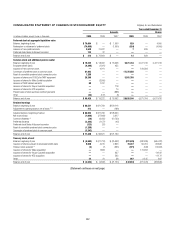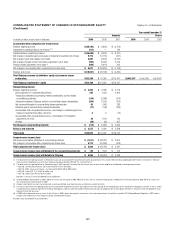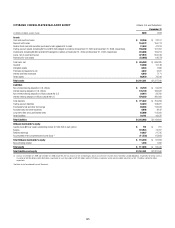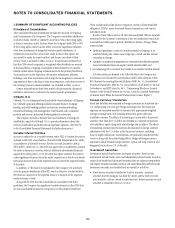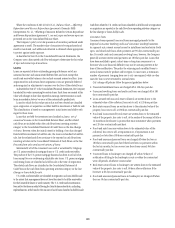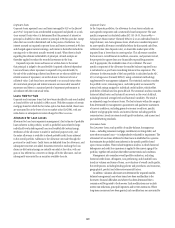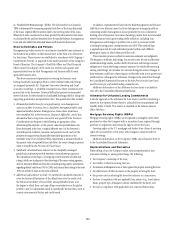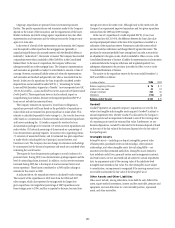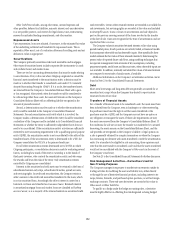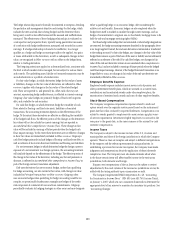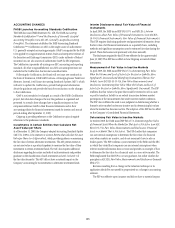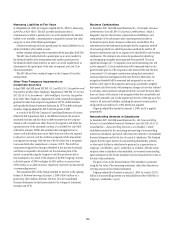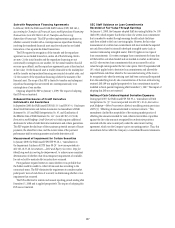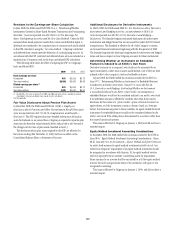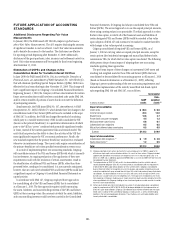Citibank 2009 Annual Report Download - page 141
Download and view the complete annual report
Please find page 141 of the 2009 Citibank annual report below. You can navigate through the pages in the report by either clicking on the pages listed below, or by using the keyword search tool below to find specific information within the annual report.
131
Citigroup’s repurchases are primarily from Government Sponsored
Entities. The specific representations and warranties made by the Company
depend on the nature of the transaction and the requirements of the buyer.
Market conditions and credit-ratings agency requirements may also affect
representations and warranties and the other provisions the Company may
agree to in loan sales.
In the event of a breach of the representations and warranties, the Company
may be required to either repurchase the mortgage loans (generally at
unpaid principal balance plus accrued interest) with the identified defects or
indemnify (“make-whole”) the investor or insurer. The Company has recorded
a repurchase reserve that is included in Other liabilities in the Consolidated
Balance Sheet. In the case of a repurchase, the Company will bear any
subsequent credit loss on the mortgage loans. The Company’s representations
and warranties are generally not subject to stated limits in amount or time of
coverage. However, contractual liability arises only when the representations
and warranties are breached and generally only when a loss results from the
breach. In the case of a repurchase, the loan is typically considered a credit-
impaired loan and accounted for under SOP 03-3, “Accounting for Certain
Loans and Debt Securities, Acquired in a Transfer” (now incorporated into ASC
310-30, Receivables—Loans and Debt Securities Acquired with Deteriorated
Credit Quality). These repurchases have not had a material impact on
nonperforming loan statistics, because credit-impaired purchased SOP 03-3
loans are not included in nonaccrual loans.
The Company estimates its exposure to losses from its obligation to
repurchase previously sold loans based on the probability of repurchase or
make-whole and an estimated loss given repurchase or make-whole. This
estimate is calculated separately by sales vintage (i.e., the year the loans were
sold) based on a combination of historical trends and forecasted repurchases
and losses considering the: (1) trends in requests by investors for loan
documentation packages to be reviewed; (2) trends in recent repurchases and
make-wholes; (3) historical percentage of claims made as a percentage of
loan documentation package requests; (4) success rate in appealing claims;
(5) inventory of unresolved claims; and (6) estimated loss given repurchase
or make-whole, including the loss of principal, accrued interest, and
foreclosure costs. The Company does not change its estimation methodology
by counterparty, but the historical experience and trends are considered when
evaluating the overall reserve.
The request for loan documentation packages is an early indicator of a
potential claim. During 2009, loan documentation package requests and the
level of outstanding claims increased. In addition, our loss severity estimates
increased during 2009 due to the impact of macroeconomic factors and
recent experience. These factors contributed to a $493 million change in
estimate for this reserve in 2009.
As indicated above, the repurchase reserve is calculated by sales vintage.
The majority of the repurchases in 2009 were from the 2006 and 2007
sales vintages, which also represent the vintages with the largest loss-
given-repurchase. An insignificant percentage of 2009 repurchases were
from vintages prior to 2006, and this is expected to decrease, because those
vintages are later in the credit cycle. Although early in the credit cycle, the
Company has experienced improved repurchase and loss-given-repurchase
statistics from the 2008 and 2009 vintages.
In the case of a repurchase of a credit-impaired SOP 03-3 loan (now
incorporated into ASC 310-30), the difference between the loan’s fair value
and unpaid principal balance at the time of the repurchase is recorded as a
utilization of the repurchase reserve. Payments to make the investor whole
are also treated as utilizations and charged directly against the reserve. The
provision for estimated probable losses arising from loan sales is recorded as
an adjustment to the gain on sale, which is included in Other revenue in the
Consolidated Statement of Income. A liability for representations and warranties
is estimated when the Company sells loans and is updated quarterly. Any
subsequent adjustment to the provision is recorded in Other revenue in the
Consolidated Statement of Income.
The activity in the repurchase reserve for the years ended December 31,
2009 and 2008 is as follows:
In millions of dollars 2009 2008
Balance, beginning of the year $ 75 $ 2
Additions for new sales 33 23
Change in estimate 493 59
Utilizations (119) (9)
Balance, end of the year $ 482 $ 75
Goodwill
Goodwill represents an acquired company’s acquisition cost over the fair
value of net tangible and intangible assets acquired. Goodwill is subject to
annual impairment tests, whereby Goodwill is allocated to the Company’s
reporting units and an impairment is deemed to exist if the carrying value
of a reporting unit exceeds its estimated fair value. Furthermore, on any
business dispositions, Goodwill is allocated to the business disposed of based
on the ratio of the fair value of the business disposed of to the fair value of
the reporting unit.
Intangible Assets
Intangible assets—including core deposit intangibles, present value
of future profits, purchased credit card relationships, other customer
relationships, and other intangible assets, but excluding MSRs—are
amortized over their estimated useful lives. Intangible assets deemed to
have indefinite useful lives, primarily certain asset management contracts
and trade names, are not amortized and are subject to annual impairment
tests. An impairment exists if the carrying value of the indefinite-lived
intangible asset exceeds its fair value. For other Intangible assets subject
to amortization, an impairment is recognized if the carrying amount is not
recoverable and exceeds the fair value of the Intangible asset.
Other Assets and Other Liabilities
Other assets include, among other items, loans held-for-sale, deferred tax
assets, equity-method investments, interest and fees receivable, premises and
equipment, end-user derivatives in a net receivable position, repossessed
assets, and other receivables.



